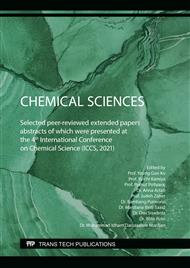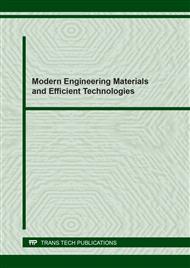[1]
The Central Bureau of Statistics, Indonesian Environmental Statistics 2018, The Central Bureau of Statistics, p.1–43, (2018).
Google Scholar
[2]
United Nations Environment Programme, Single-Use Plastics: A Roadmap for Sustainability, The International Environmental Technology Centre, Osaka, (2018).
Google Scholar
[3]
OA Alabi, KI. Ologbonjaye, O. Awosolu, O.E. Alalade, Public and environmental health effects of plastic wastes disposal: A review, J. Toxicol. Risk Assess. 5 (2009), 021.
Google Scholar
[4]
YA Hidayat, S. Kiranamahsa, M.A. Zamal, A study of plastic waste management effectiveness in Indonesia industries, AIMS Energy 7 (2019) 350–370.
DOI: 10.3934/energy.2019.3.350
Google Scholar
[5]
National Plastic Action Partnership, Radically Reducing Plastic Pollution in Indonesia: A Multistakeholder Action Plan, World Economic Forum, (2020).
Google Scholar
[6]
L. Warlina, Pengelolaan sampah plastik untuk mitigasi bencana lingkungan, in: Diki, S. Utami, Y.T. Hewindati, E, Herlinawati (Eds.), Peran Matematika, Sains dan Teknologi dalam Kebencanaan, Universitas Terbuka, Banten, 2019, p.89–110.
Google Scholar
[7]
A.D. Astuti, J. Wahyudi, A. Ernawati, S.Q. Aini, Kajian pendirian usaha biji plastik di kabupaten Pati, Jawa Tengah, Jurnal Litbang: Media Informasi Penelitian, Pengembangan dan Iptek 16 (2020) 95–112.
DOI: 10.33658/jl.v16i2.204
Google Scholar
[8]
H. Chandara, Sunjoto, Sarto, Plastic recycling in Indonesia by converting plastic wastes (PET, HDPE, LDPE, and PP) into plastic pellets, AJSE 3 (2016) 65–72.
DOI: 10.22146/ajse.v3i2.17162
Google Scholar
[9]
H. Sawir, Pemanfaatan sampah plastik menjadi briket sebagai bahan bakar alternatif dalam kiln di pabrik PT Semen Padang, Jurnal Sains dan Teknologi 16 (2016) 1–8.
DOI: 10.36275/stsp.v16i1.56
Google Scholar
[10]
M.P. Groover, Fundamentals of Modern Manufacturing Materials Processes and Systems, 4th ed., John Wiley & Sons, Hoboken, New Jersey, (2010).
Google Scholar
[11]
A. Hafiz, Aplikasi penghitungan pemakaian listrik rumah tangga berbasis android, JuPerSaTeK 2 (2019), 1–8.
Google Scholar
[12]
Ministry of Energy and Mineral Resources Republic of Indonesia, Peraturan Menteri Energi dan Sumber Daya Mineral tentang Pembelian Tenaga Listrik dari Pembangkit Listrik Tenaga Surya Fotovoltaik oleh PT Perusahaan Listrik Negara (Persero), Permen ESDM No. 19 Tahun 2016, p.13–19, (2016).
DOI: 10.32520/das-sollen.v5i1.1647
Google Scholar
[13]
European Commission, Guide to Cost-Benefit Analysis of Investment Projects no. 1910, The European Commission, (2008).
Google Scholar
[14]
RTS. Siagian, M.S. Surbakti, Preliminary Analysis of Economic and Financial Feasibility in Medan City Monorail Planning, The 18th FSTPT International Symposium, University of Lampung, (2015).
Google Scholar
[15]
H. Umar, Studi Kelayakan Bisnis, Gramedia Pustaka Utama, Jakarta, (2003).
Google Scholar
[16]
M. Giatman, Ekonomi Teknik, 3rd ed., PT Raja Grafindo Persada, Jakarta, (2013).
Google Scholar
[17]
W. Hielg, R. Janssen, Advancement of Pellets-related European Standards, WIP Renewable Energies, Munich, (2009).
Google Scholar
[18]
G.I. Bisharat, V.P. Oikonomopoulou, N.M. Panagiotou, M.K. Krokida, Z.B. Maroulis, Effect of extrusion conditions on the structural properties of corn extrudates enriched with dehydrated vegetables, Food Research International, 53 (2013) 1–14.
DOI: 10.1016/j.foodres.2013.03.043
Google Scholar
[19]
J. Goff, T. Whelan, D. Delaney, The Dynisco Extrusion Processors Handbook, 2nd ed., Dynisco Inc., Franklin, Massachusetts, (2000).
Google Scholar
[20]
O. Kurniawan, Marsono, Superkarbon: Bahan Bakar Alternatif Pengganti Minyak Tanah dan Gas, Penebar Swadaya, Jakarta, (2008).
Google Scholar
[21]
B. Jabłonska, P. Kiełbasa, M. Korenko, T. Drózdz, Physical and chemical properties of waste from PET bottles washing as a component of solid fuels, Energies 12 (2019) 2197.
DOI: 10.3390/en12112197
Google Scholar
[22]
W. Paramita, DM Hartono, T.E.B. Soesilo, Sustainability of refuse derived fuel potential from municipal solid waste for cement's alternative fuel in Indonesia (A case at Jeruklegi landfill, in Cilacap), IOP Conf. Ser.: Earth Environ. Sci. 159 (2018) 012027.
DOI: 10.1088/1755-1315/159/1/012027
Google Scholar



